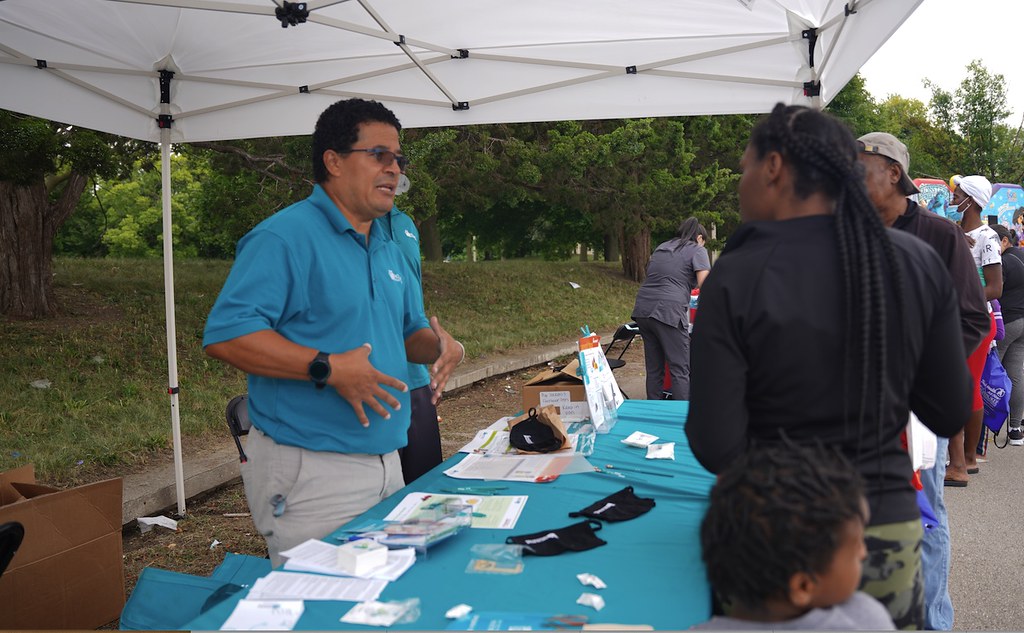Why Have So Few Children in County Gotten Updated COVID Vaccine?
Only 2.9% of children ages 5 to 11 have received an updated dose.

Javier Rivers of Molina Healthcare of Wisconsin answers questions at a community health and wellness resource fair in August, where 140 vaccines were ultimately administered. (Photo by Terrance Sims provided by INPOWER)
The number of young children in Milwaukee County who have received the updated COVID-19 vaccines remains very low in general, and slightly lower than the rest of the state, despite the county being at a “medium” level of hazard posed by COVID-19.
The Centers for Disease Control and Prevention, or CDC, announced its approval of the updated, or bivalent, vaccines for 5- to 11-year-olds on Oct. 12.
Dr. Benjamin Weston, chief health policy adviser for Milwaukee County, wants parents to understand the high degree of safety of vaccines and boosters.
“This new booster uses the same vaccine mechanism that has been proven safe … . It’s just a change in the recipe,” Weston said during a news conference last month. “Vaccines have been shown to be incredibly safe to all age groups.”
While there have been some observed side effects of the shots, such as fever and fatigue, these are well within the normal range of side effects associated with other vaccines, he said. Moreover, “the benefits of vaccination far outweigh” the dangers of COVID-19, Weston said.
Although the vaccines are free and available to people throughout the county, there does not seem to be a great demand for the shots.
“There’s so much noise in the conversation around COVID,” said Jennifer Kates, senior vice president at the Henry J. Kaiser Family Foundation, a nonprofit that conducts health care research and provides health policy analysis.
“People are sort of just no longer able to receive the message because they’ve been hearing about COVID for so long. It’s harder for them to hear those messages or for us to deliver them in ways that folks can hear them,” said Katie Lepak, project officer for the Milwaukee County Public Health Collaborative, an ongoing collaboration among health departments, hospitals, community clinics and pharmacies to carry out a unified public response to the pandemic.
‘It takes more effort’
In addition to this COVID saturation, “there are structural challenges,” said Kates. “Getting a booster isn’t the same as the beginning days of getting a vaccine.”
“You have to more actively seek it out,” she said. “It takes more effort.”
North Side resident Kay Smith, 68, said she “mostly heard about it on the news” but “would have loved” more outreach from the city about the boosters.
She has grandchildren and great-grandchildren and worries about their health as well as the health of the family members they live with.
Phyllis Thompson, 62, lives on the West Side, and her 8-year-old daughter took it upon herself to learn about vaccines and boosters, out of concern for family as well.
“Basically, it was her decision,” Thompson said. “She wanted to receive the vaccine because her grandmother – her grandmother basically is not in good health – and she basically said she wanted to protect her grandmother … .”
“I have a knowledgeable 8-year-old,” she added.
To this end, the Milwaukee County Public Health Collaborative promotes Healthy MKE, a website that provides up-to-date information and resources regarding providers, testing and vaccines.
“How do we get people to get back in front of their provider to have a conversation with somebody they already have a relationship with?” asked Aziz Abdullah, co-founder of INPOWER, a communications agency located in Harambee that built and manages the Healthy MKE site.
And for those who do not have a trusted provider, Healthy MKE has just published content that incorporates feedback from the community “to call out questions we know people are having,” Abdullah said.
Of particular relevance to North and South Side residents is the collaborative’s work with community clinics, sometimes known as Federally Qualified Health Centers, or FQHCs.
These clinics are mandated to serve underinsured and uninsured people.
“In fact,” said Kates, “during the COVID emergency, they were given additional support to do vaccination for communities they serve and get that information out. They are reaching the communities that are the hardest to reach.”
As a whole, however, these clinics, of which there are five in the county, have experienced workforce issues that have limited their ability to reach out formally as well as to administer vaccines.
In an email, Allison Kos, chief medical officer for Progressive Community Health Centers, or PCHC, said, “due to staffing and workforce limitations, PCHC had to suspend our own onsite COVID-19 vaccination efforts.”
“In the early stages of the pandemic, we were able to organize and galvanize people to do community events,” Abdullah said. “And I think those general, open community events are not as open right now maybe due to workforce challenges that we are seeing.”
Abdullah said other members of the county’s collaborative are helping to bridge the gap, though.
For example, PCHC and the Wisconsin Department of Health Services collaborated on several vaccination clinics at the end of October through mid-November.
Why are so few young children in Milwaukee County getting the updated COVID boosters? was originally published by Milwaukee Neighborhood News Service.





















Republican have spread false information about vaccines as part of their culture war. People died because they believed the Republican lies about vaccines. That suspicion continues today with many parents who are not taking the time to find out about the need for Covid vaccine boosters. Medical costs go up for all of us as children get sick and some of them tragically die.